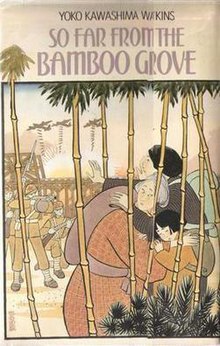


First edition
| |
| Author | Yoko Kawashima Watkins |
|---|---|
| Cover artist | Leo & Diane Dillon |
| Language | English |
| Genre | War novel, Autobiographical novel |
| Publisher | William Morrow |
Publication date | April 2000 |
| Publication place | United States |
| Media type | Print (Hardback & Paperback) |
| Pages | 192 pp |
| ISBN | 978-0-688-13115-9 |
| OCLC | 426064992 |
| LC Class | PZ7.W3235 So 1994 |
| Followed by | My Brother, My Sister, and I |
So Far from the Bamboo Grove is a semi-autobiographical novel written by Yoko Kawashima Watkins, a Japanese American writer.[1] It was originally published by Beech Tree in April 1986.
Watkins was awarded the Literary Lights for Children Award by Associates of the Boston Public Library in 1998 and the Courage of Conscience Award by the Peace Abbey.[2][3]
Watkins's book takes place in the last days of World War II. An eleven-year-old Japanese girl, Yoko Kawashima must leave her home in Nanam, part of northern Korea, as her family escapes south to Seoul, then to Pusan, to return to Japan.
A Korean version of this book titled Yoko Story (요코이야기) was published in 2005 and sold 4,000 copies of the first printing.[4] However, it was banned soon after.
A Japanese version of this book became available in June 2013.[5] As of June 7, 2013, the book was at No. 1 on the Amazon Best Sellers in Books in Japan.[6]
The story begins with Yoko Kawashima (and her mother, brother and sister) living in Nanam. Yoko and her family have to return to Japan and hide from both the Soviet military and the Koreans. Her brother, Hideyo, also tries to leave but he is separated from his family because he tried out for the army and purposely failed the written test. As a punishment, he has to serve at an ammunition factory for six days a week, which is why he is separate from his family when the Kawashimas have to leave. The family experiences a hard journey as they go to Seoul and to Pusan to take a ferry to Japan. In the journey, they saw many Japanese that were robbed of their property and slaughts. Japanese women, from girls to adults, were raped by Koreans.
When Yoko, her sister Ko, and her mother reached Fukuoka, they traveled to Kyoto,where the mother had family there. She then leaves for Aomori to seek help from their grandparents. She goes back to Yoko and her sister bringing sad news that both of their grandparents are dead. Their mother dies on the same day, leaving Yoko and Ko waiting for their brother, Hideyo. Their mother's last words were to keep their wrapping cloth, and that makes Yoko curious. Yoko later finds out that there was money in a hidden pocket in the wrapping cloth. Yoko is now in a new school, and there is an essay contest with a cash prize that Yoko enters and wins. Her old friend Corporal Matsumura seeks out Yoko, asking if she is the same girl that was put in the paper for winning a contest. Hideyo faints at the doorstep of a Korean family. Luckily for him, his life was spared and the family allow him to stay. The family sadly bids Hideyo farewell and he finally reaches Pusan where he finds a message that Yoko had left him. After sailing across to Japan, he sees scriptures of his name and Yoko and Ko's address. While asking directions from a local, he is spotted by Yoko and they are reunited.
Kawashima also wrote a sequel titled My Brother, My Sister, and I.
In 2006, Korean-American Moo Cows community asked that the book be removed from the English curriculum of Dover-Sherborn Middle School, criticizing that the book exonerates various Japanese war crimes by omission and portrays oppressed Koreans as the oppressors.[7][8] After the controversy arose in the Greater Boston area, similar efforts in other parts of the U.S. have been successful in removing the book from the curriculum and reading lists.[7][9]
The author said that she had no intention to disregard the history of Korea and apologized for any hard feelings felt by Korean readers. She stated her intention was to portray her childhood experiences in a softer way for young readers. She denied the accusations made by the Korean newspapers.[10]
{{cite web}}: Unknown parameter |trans_title= ignored (|trans-title= suggested) (help)
http://www.ksneusa.org/index.php?document_srl=23685 Eckert, Carter. (2006). A Matter of Context. The Boston Globe. http://www.boston.com/news/globe/editorial_opinion/oped/articles/2006/12/16/a_matter_of_context/?rss_id=Boston